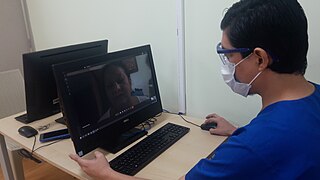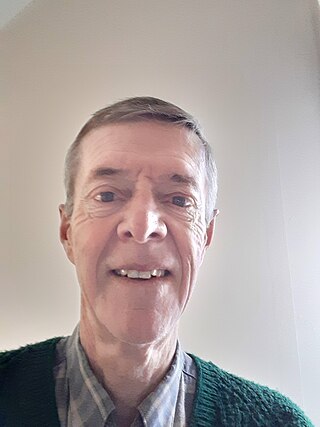The following outline is provided as an overview of and topical guide to health sciences:
Medical physics deals with the application of the concepts and methods of physics to the prevention, diagnosis and treatment of human diseases with a specific goal of improving human health and well-being. Since 2008, medical physics has been included as a health profession according to International Standard Classification of Occupation of the International Labour Organization.

Medical imaging is the technique and process of imaging the interior of a body for clinical analysis and medical intervention, as well as visual representation of the function of some organs or tissues (physiology). Medical imaging seeks to reveal internal structures hidden by the skin and bones, as well as to diagnose and treat disease. Medical imaging also establishes a database of normal anatomy and physiology to make it possible to identify abnormalities. Although imaging of removed organs and tissues can be performed for medical reasons, such procedures are usually considered part of pathology instead of medical imaging.

Telehealth is the distribution of health-related services and information via electronic information and telecommunication technologies. It allows long-distance patient and clinician contact, care, advice, reminders, education, intervention, monitoring, and remote admissions. Telemedicine is sometimes used as a synonym, or is used in a more limited sense to describe remote clinical services, such as diagnosis and monitoring. When rural settings, lack of transport, a lack of mobility, conditions due to outbreaks, epidemics or pandemics, decreased funding, or a lack of staff restrict access to care, telehealth may bridge the gap as well as provide distance-learning; meetings, supervision, and presentations between practitioners; online information and health data management and healthcare system integration. Telehealth could include two clinicians discussing a case over video conference; a robotic surgery occurring through remote access; physical therapy done via digital monitoring instruments, live feed and application combinations; tests being forwarded between facilities for interpretation by a higher specialist; home monitoring through continuous sending of patient health data; client to practitioner online conference; or even videophone interpretation during a consult.

UBC Hospital is a teaching hospital located on the University Endowment Lands in Vancouver, British Columbia, Canada. It opened in 1968, and is now operated by Vancouver Coastal Health.

The Ionian University(IU) (Greek: Ιόνιο Πανεπιστήμιο) is a university located in the Ionian Islands, Greece. It is one of the newest institutions of Higher Education in Greece, created in 1984 pursuant to presidential order 83/84 ΦΕΚ 31 Α/20-3-84, along with the University of the Aegean and the University of Thessaly. In 2018, TEI of Ionian islands merged into the Ionian University.

The Regional Cancer Centre (RCC) at Thiruvananthapuram is a cancer care hospital and research centre. RCC was established in 1981 by the Government of Kerala and the Government of India. It is located in the Thiruvananthapuram Medical College campus in Thiruvananthapuram, the capital city of the state of Kerala. It was established as an expansion of the Radiation Therapy / Radiotherapy department of Medical College Trivandrum. It is a tertiary care center for the managements of all types of cancers. The clinics are mainly on Haematology, Lymphoreticular, soft tissue, bone, head and neck, breast, CNS, gynaecological, urinary, chest, gastro, paediatric oncology and thyroid.

The Centre for Development of Advanced Computing, Thiruvananthapuram (C-DAC[T]) is a branch of the Indian Centre for Development of Advanced Computing based in Thiruvananthapuram.

Leonardo Bianchi, an Italian neuropathologist, politician, and writer from San Bartolomeo in Galdo in the Province of Benevento, earned fame from his work on cerebral functions and diseases of the nervous system. His work contributed to the very first known handbook of neurological semiology and examination in Italy.
Imaging informatics, also known as radiology informatics or medical imaging informatics, is a subspecialty of biomedical informatics that aims to improve the efficiency, accuracy, usability and reliability of medical imaging services within the healthcare enterprise. It is devoted to the study of how information about and contained within medical images is retrieved, analyzed, enhanced, and exchanged throughout the medical enterprise.

The School of Medical Science and Technology (SMST) is an educational and research institute affiliated to the Indian Institute of Technology, Kharagpur, India. Founded in 2001, the School of Medical Science and Technology brings together doctors, scientists and engineers to work collaboratively on projects for better healthcare.
The Pan-African e-Network project is an information and communications technology (ICT) project between India and the African Union that seeks to connect the 55 member states of the Union through a satellite and fibre-optic network to India and to each other to enable access to and sharing of expertise between India and African states in the areas of tele-education, telemedicine, Voice over IP, infotainment, resource mapping, meteorological services, e-governance and e-commerce services. The project is often described as Africa's biggest ever in the ICT sector and is expected to extend ICT infrastructure to rural and previously underserved areas. The project is seen as an example of India furthering its economic and strategic interests in Africa through the use of soft diplomacy and has been acclaimed as an instance of South–South cooperation, helping to overcome the digital divide in Africa.
A knowledge society generates, shares, and makes available to all members of the society knowledge that may be used to improve the human condition. A knowledge society differs from an information society in that the former serves to transform information into resources that allow society to take effective action, while the latter only creates and disseminates the raw data. The capacity to gather and analyze information has existed throughout human history. However, the idea of the present-day knowledge society is based on the vast increase in data creation and information dissemination that results from the innovation of information technologies. The UNESCO World Report addresses the definition, content and future of knowledge societies.

Ronald S. Weinstein was an American pathologist. He was a professor at the University of Arizona College of Medicine-Tucson. Weinstein served for 32 years as an academic pathology department chair, in Chicago, Illinois and then Tucson, Arizona, while also serving as a serial entrepreneur engaged in university technology transfer.

The Observatory on Digital Communication (OCCAM) was established in 1996 by UNESCO in Milan, with the Agreements signed by the director general, Federico Mayor and Marco Formentini in June 1996. The acronym stands for Observatory for Cultural Communication and Audiovisual in the Mediterranean.

Peter Yellowlees is a British-born American physician, researcher, entrepreneur, academic and administrator. He is Distinguished Emeritus Professor of General Psychiatry at University of California, Davis and is the Chief Executive Officer and Founder of Asynchealth Inc. He was the inaugural Chief Wellness Officer at UC Davis and held the Alan Stoudemire Endowed Chair in Psychiatry as the Director of Physician Health Program at UC Davis Psychiatry. He chaired the UCDH Wellbeing Committee.
Bernd Blobel is a scientist recognized for his contributions to the field of health informatics. He is a professor at the Faculty of Medicine of the University of Regensburg, Germany, and visiting professor at the First Faculty of Medicine of the Charles University of Prague, Czech Republic. His main areas of research include electronic medical records, security, privacy and interoperability, information systems architectures in health, telemedicine and biomedicine, engineering, translational medicine, knowledge representation, and ontologies. He has received numerous recognitions for his scientific career, among which are: Fellow of the American College of Medical Informatics (ACMI) (2004), Fellow of HL7 International (2010), Fellow of the Australasian College of Health Informatics (ACHI) (2011), Honorary Fellow of the European Federation of Medical Informatics (EFMI) (2015), Inaugural Fellow of the International Academy of Health Sciences and Informatics (IAHSI) (2017), and Honorary Fellow of the EuroMISE Mentors Association, as well as Honorary Fellow of HL7 Germany and the Society for Biomedical Engineering and Medical Informatics of the Czech Republic. He is the author of more than 200 high-impact scientific articles, including the book Analysis, Design and Implementation of Secure and Interoperable Distributed Health Information Systems.
Sergey Pavlovich Morozov is a Russian radiologist and healthcare official.

Ewart R Carson is a British chartered engineer, system scientist, author, and academic. He is a Professor Emeritus of Systems Science in the School of Science and Technology at City, University of London.
Charles Safran is an American-born physician, biomedical informatician, and professor, who is known for his work regarding the use of health information technology (HIT) to improve the delivery and quality of healthcare, in particular clinical information systems.










